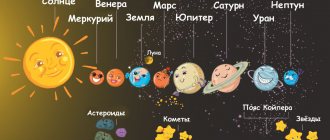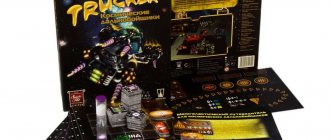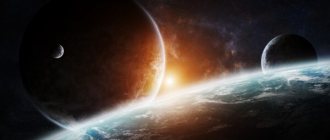Astronomy for children > Solar system
Description of the planets of the Solar System for children: consider the model of the Solar System and all the planets in order with photos and drawings, interesting facts about the Sun.
The solar system is a huge place with a lot of empty space between the planets. But there are also asteroids, comets, rocky and icy objects, and dwarf planets in the Kuiper Belt and Oort Cloud that have yet to be explored.
For the little ones , you need to know that the Solar System is represented by the Sun and the objects revolving around it: planets, asteroids, meteorites, comets and satellites. All of them extend from the main star (the ancient Romans called it "Sol") and pass the four inner planets through the Asteroid Belt to the four gas giants, the Kuiper Belt (disc-shaped) and beyond the giant Oort Cloud (spherical shape) and the teardrop heliopause . Researchers believe that the edge of the system is 15 billion km from the star.
This article will reveal the most interesting facts about the Solar System for children and provide a complete description of all planets and objects with photos, drawings, pictures and videos. In addition, you will find out which planet is the largest or smallest, the first and the last, hot and cold. Be sure to consider the diagram with the location and orbits, where all the planets of the Solar System are in full view.
Discovery of the Solar System - for children
Parents or teachers at school can start explaining to children by discovering our system. Astronomers did not stop admiring the shine of the stars in the sky and tracking their movements. The ancient Greeks called these points planets - “wanderers”. Children will be surprised, but Mercury, Venus, Mars, Jupiter and Saturn were already known then, and the advent of telescopes only added to the Asteroid Belt, Uranus, Neptune, Pluto and their satellites. With the development of space research, many probes have been launched into space, which continue to further expand the boundaries of understanding the system. With the discovery of Eris, the era of dwarf planets began.
Since January 20, 2021, scientists have been tracking the mysterious Planet Nine (10 times the mass of Earth and 5,000 times the mass of Pluto).
Terrestrial planets
Mercury
The smallest planet in the solar system has a radius of only 2440 km. The period of revolution around the Sun, equated to an earthly year for ease of understanding, is 88 days, while Mercury manages to rotate around its own axis only one and a half times. Thus, his day lasts approximately 59 Earth days. For a long time it was believed that this planet always turned the same side to the Sun, since periods of its visibility from Earth were repeated with a frequency approximately equal to four Mercury days. This misconception was dispelled with the advent of the ability to use radar research and conduct continuous observations using space stations. The orbit of Mercury is one of the most unstable; not only the speed of movement and its distance from the Sun change, but also the position itself. Anyone interested can observe this effect.
Mercury in color, image from the MESSENGER spacecraft
Its proximity to the Sun is the reason why Mercury is subject to the largest temperature changes among the planets in our system. The average daytime temperature is about 350 degrees Celsius, and the nighttime temperature is -170 °C. Sodium, oxygen, helium, potassium, hydrogen and argon were detected in the atmosphere. There is a theory that it was previously a satellite of Venus, but so far this remains unproven. It does not have its own satellites.
Venus
The second planet from the Sun, the atmosphere is almost entirely composed of carbon dioxide. It is often called the Morning Star and the Evening Star, because it is the first of the stars to become visible after sunset, just as before dawn it continues to be visible even when all the other stars have disappeared from view. The percentage of carbon dioxide in the atmosphere is 96%, there is relatively little nitrogen in it - almost 4%, and water vapor and oxygen are present in very small quantities.
Venus in the UV spectrum
Such an atmosphere creates a greenhouse effect; the temperature on the surface is even higher than that of Mercury and reaches 475 °C. Considered the slowest, a Venusian day lasts 243 Earth days, which is almost equal to a year on Venus - 225 Earth days. Many call it Earth's sister because of its mass and radius, the values of which are very close to those of Earth. The radius of Venus is 6052 km (0.85% of Earth's). Like Mercury, there are no satellites.
Earth
The third planet from the Sun and the only one in our system where there is liquid water on the surface, without which life on the planet could not have developed. At least life as we know it. The radius of the Earth is 6371 km and, unlike other celestial bodies in our system, more than 70% of its surface is covered with water. The rest of the space is occupied by continents. Another feature of the Earth is the tectonic plates hidden under the planet's mantle. At the same time, they are able to move, albeit at a very low speed, which over time causes changes in the landscape. The speed of the planet moving along it is 29-30 km/sec.
Our planet from space
One revolution around its axis takes almost 24 hours, and a complete passage through the orbit lasts 365 days, which is much longer in comparison with its closest neighboring planets. The Earth's day and year are also accepted as a standard, but this is done only for the convenience of perceiving time periods on other planets. The Earth has one natural satellite - the Moon.
Mars
Mars as seen by the Hubble Space Telescope in 2003
The fourth planet from the Sun, known for its thin atmosphere. Since 1960, Mars has been actively explored by scientists from several countries, including the USSR and the USA. Not all exploration programs have been successful, but water found at some sites suggests that primitive life exists on Mars, or existed in the past.
The brightness of this planet allows it to be seen from Earth without any instruments. Moreover, once every 15-17 years, during the Confrontation, it becomes the brightest object in the sky, eclipsing even Jupiter and Venus.
The radius is almost half that of Earth and is 3390 km, but the year is much longer - 687 days. He has 2 satellites - Phobos and Deimos .
Formation of the Solar System - for children
Most researchers agree that the solar system emerged from a giant rotating cloud of gas and dust - the solar nebula. It is important to explain to children that as gravity increases, it expands, accelerates rotation and flattens into a disk shape. Most of the material concentrated in the center to create the main star, the Sun. The rest of the material continued to collide and combine until it became comets, asteroids, moons and planets.
Children should know that the solar wind was so powerful that it swept light elements (hydrogen and helium) away from the inner planets, leaving behind rocky formations. In the outer regions it weakened, allowing gas giants to form.
Our galaxy
Our galaxy is called the Milky Way. According to scientists, the Milky Way is a spiral system with a diameter of about 100 thousand light years and a thickness of 1 light year.
Also, according to their calculations, there are 150–200 billion stars in it and a huge number of other, very diverse space objects.
How to see the Milky Way
Theoretically, you can see the Milky Way at any time of the year in any part of the world, but the best months for viewing are from about mid-March to mid-October.
It is impossible to see the Milky Way from cities, and even villages, due to light pollution. Therefore, you need to drive as far as possible from populated areas.
Internal system - for children
There are 4 relatively small inner planets of the solar system: Mercury, Venus, Earth and Mars. They are similar in composition (iron and rock) and size, which is why they are called terrestrial planets. The Earth has one satellite, and Mars has two (Deimos and Phobos). Previously, Pluto was in first place in terms of tinyness, but since 2006 it has been classified as a dwarf planet. Now Mercury is the smallest planet in the solar system.
In the area between Mars and Jupiter is the Asteroid Belt. These are small stone fragments with a diameter of 1 km. Children should know that an incredible number of celestial bodies rotate there. The dwarf planet Ceres (950 km) is also located here. Some asteroids have orbits that cause them to move toward the solar system. Because of this, there have been so many collisions with our planet and other planets in the past.
Mercury
Venus
Earth
Mars
Galaxy
As you know, every person has an address where he lives. The planets also have such an address. For example, the Earth “lives” in a galaxy called the Milky Way.
What is a Galaxy? It is a huge system containing many interconnected planets, stars and dust, as well as interstellar gas.
It is like a city with many houses, shops, schools and other buildings. Nobody knows how many galaxies there are, but what is certain is that there are very, very many of them.
And in this big galaxy called the Milky Way, there are separate systems (like separate streets in a city). The Earth “lives” in the solar system. It is called solar because it is around the Sun that all the planets “living” in this system revolve.
External system - for children
This includes the major planets: Jupiter, Saturn, Uranus and Neptune. These are huge worlds with thick gas layers. It is important to explain to the youngest children that almost all of their mass is represented by hydrogen and helium, which is why they resemble the Sun in composition. There is no solid surface beneath these layers, although there may be a rocky core. Around them there are rings of rocks and ice (the most famous are those of Saturn). Of course, Jupiter is the largest planet in the solar system.
Comets are often called dirty snowballs because they are made of ice and rock. When their orbit is directed toward the Sun, some of the ice in the central core turns into gas, which is sprayed into space in the form of a long tail. There are comets with a short periodicity (200 years) that emerge from the Kuiper belt. But with a long periodicity - objects of the Oort cloud.
Jupiter
Saturn
Uranus
Neptune
Pluto
Children about space. The sun is the source of life on Earth
CHILDREN ABOUT SPACE. THE SUN IS THE SOURCE OF LIFE ON EARTH. CONVERSATION THREE.
(
T.
A.
Shorygina .
Children about space and Yuri Gagarin
-
the first cosmonaut of the Earth
: Conversations, leisure, stories. - M.: Sfera, 2014.-128 pp. )
Life shows that space will also be explored
not some supermen, but the simplest people.
(Yuri Gagarin)
About the Sun for children.
— Try to solve the riddle: “It sheds light on the earth and gives us all warmth.”
Right! This is the Sun.
— Do you remember why the ancient Slavs called the Sun Dazhdbog?
Yes, the Sun gives us light and warmth. After a cold, cloudy winter, people and animals especially rejoice in its gentle rays.
— What is the name of the holiday dedicated to seeing off winter and welcoming spring?
That's right, Maslenitsa. On this holiday they burned bonfires, danced in circles, praised the Sun with songs and hurried it to turn towards summer.
“On Maslenitsa - joy to the sun!” - people said.
On Maslenitsa
We are on Shrovetide Week We will burn fires hotly, So that sparks fly Above the earth to all ends, So that the Sun will be awakened: “Lighten us and warm us!” Show yourself in beauty and strength. We have been waiting for you for many days!”
We are on Shrovetide Week
Let's bake a golden brown pancake:
"Sun! Get out of bed!
We want to treat you!”
— Why do they bake pancakes on Maslenitsa?
Damn reminds us of the hot sun.
If you look at the sky, the Sun appears flat and small. But in fact, it is a huge fireball consisting of hot gases.
The sun seems small to us because it is very far from us, at a distance of 150 million km.
Interesting facts - Sun.
Even light, which travels three hundred thousand kilometers in one second, reaches the Earth in 8 minutes.
- Let's think together about what the Earth and the Sun have in common and how they differ.
The Sun and Earth are spherical in shape. Both celestial bodies move in outer space. But the Sun is a star, and the Earth is a plane. Stars are made of hot gases and emit bright light and heat into the surrounding space. The earth is a solid ball, its surface is not hot. (Although scientists suggest that there is a hot molten core at the center of the Earth.) The Sun is very hot, and its surface is gases.
The planets themselves do not glow. These are huge balls illuminated by stars, such as the Sun.
Finally, the Sun is many times larger than the Earth.
If you imagine the Earth in the form of a grain of wheat, then the Sun next to it will be the size of a watermelon. It is 109 times larger than Earth!
There are larger and brighter stars in outer space, but the Sun is the closest star to us.
— Why is the Sun called the source of life on Earth?
If the Sun did not warm and illuminate the Earth with its rays, then our planet would turn into a dead icy desert, where eternal night would reign.
The plants would die. After all, they need sunlight and warmth to live.
And plants, in turn, feed people and animals. In addition, plants take carbon dioxide from the atmosphere and release oxygen into it, which we need for breathing.
So it turns out that thanks to the Sun there are plants, animals, and people on Earth!
* * *
The sun is shining from the high sky - Adults and children are glad to see its rays... Animals and birds are glad to see its rays. The river shines and silvers in the sun. The sun looks at the earth with kindness,
Giving the world warmth and beauty!
— What is the name of the star closest to us?
— What shape does the Sun have? What does it consist of?
-What is bigger - the Sun or the Earth?
— Why is the Sun called the source of life on Earth?
Cartoon about the Sun.
Dear students, in my opinion, this is important!
I advise you to go through other sections of the “Navigation” and read interesting articles or watch presentations, didactic materials on subjects (pedagogy, methods of developing children's speech, theoretical foundations of interaction between preschool educational institutions and parents); material for preparing for tests, tests, exams, coursework and dissertations. I would be glad if the information posted on my website helps you in your work and study.
Best regards, O.G. Golskaya.
“Help on the site” - click on the image - hyperlink to return to the previous page (Test work on the module “Planning work on the development of children's speech. SPACE”).
Comparative table of the main parameters of planets and dwarf planets
All parameters below, except density, distance from the Sun and satellites, are indicated in relation to similar data from the Earth.
| Planet(dwarf planet) | Diameter, relative | Weight, relative | Orbital radius, a. e. | Orbital period, Earth years | Days, relative | Density, kg/m³ | Satellites |
| Mercury | 0,382 | 0,055 | 0,38 | 0,241 | 58,6 | 5427 | No |
| Venus | 0,949 | 0,815 | 0,72 | 0,615 | 243 | 5243 | No |
| Earth | 1,0 | 1,0 | 1,0 | 1,0 | 1,0 | 5515 | 1 |
| Mars | 0,53 | 0,107 | 1,52 | 1,88 | 1,03 | 3933 | 2 |
| Ceres | 0,074 | 0,00015 | 2,76 | 4,6 | 0,378 | 2161 | No |
| Jupiter | 11,2 | 318 | 5,20 | 11,86 | 0,414 | 1326 | 67 |
| Saturn | 9,41 | 95 | 9,54 | 29,46 | 0,426 | 687 | 62 |
| Uranus | 3,98 | 14,6 | 19,22 | 84,01 | 0,718 | 1270 | 27 |
| Neptune | 3,81 | 17,2 | 30,06 | 164,79 | 0,671 | 1638 | 14 |
| Pluto | 0,186 | 0,0022 | 39,2 | 248,09 | 6,387 | 1860 | 5 |
| Haumea | ~0,11 | 0,00066 | 43 | 281,1 | 0,163 | ~2600 | 2 |
| Makemake | 0,116 | ~0,0005 | 45,4 | 306,28 | 0,324 | ~1700 | No |
| Eris | 0,182 | 0,0028 | 67,8 | 558,04 | 1,1 | 2520 | 1 |
Approximate ratio of the sizes of the planets and the Sun. Interplanetary distances are not to scale. The sun is shown on the left.







